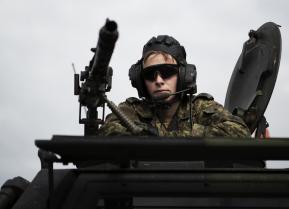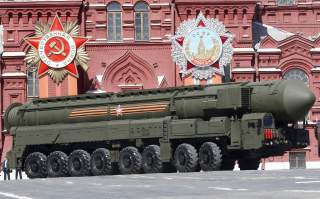How to Push Back Against Russia: The Trump Administration Must Revitalize NATO’s Nukes
NATO and the U.S. must accept as an absolute priority the need to recreate a solid, credible and capable escalation ladder with clearly delineated and identifiable capabilities are available for each rung.
Russia is a military power primarily because of its large arsenal of nuclear weapons. So central are these weapons to Moscow’s foreign and defense policies that it was even willing to deploy a new long-range, land-based cruise missile in violation of the long-standing Intermediate-Range Nuclear Weapons Treaty to bolster Russian theater nuclear force capabilities.
While Russian conventional forces have been modernized over the past decade, they are a one-trick pony, capable only of limited offensive operations against NATO in areas immediately beyond its Western borders. Russian anti-access/area denial forces are relatively brittle and intended largely to shield the homeland from the power of U.S. and Alliance air and sea forces. The Kremlin’s efforts to organize a national mobilization capability, which would be required in the event of a conflict with NATO, have been largely unsuccessful. Thus, the Russian military is really designed to support a “smash-and-grab” strategy similar to what we saw in Crimea.
Russia has built a comprehensive array of theater and strategic nuclear capabilities and has integrated them into its strategy for conducting operations against NATO across the conflict spectrum. It is important to recognize that nuclear weapons play an important part in the Russian approach to hybrid warfare.
It is generally believed that Moscow wishes to reduce its reliance on nuclear weapons in its foreign and security policies. While there has been progress in equipping the Russian Armed Forces with the kind of conventional systems that would substitute for nuclear weapons, the quantity and quality of these new capabilities are not such as to obviate reliance on the latter. Russian nuclear forces and concepts of operations are not without certain weaknesses that the U.S. and NATO should consider exploiting in order to shore up deterrence.
Russia’s nuclear forces and strategy also present many weaknesses. However, that could be subject to Western exploitation. Russia does not prefer dependence on nuclear weapons but is forced to rely on them largely to offset conventional disadvantages. This creates several problems, including imposing demands for rapid escalation in the case of successful initial operations by opposing forces and the need for exquisite intelligence to achieve a disarming first strike. Also, leaders in Moscow must confront the prospect that limited nuclear warfare might be conducted across the depths of Russia’s homeland.
NATO and the U.S. must accept as an absolute priority the need to recreate a solid, credible and capable escalation ladder with clearly delineated and identifiable capabilities are available for each rung. The U.S. has announced plans to modernize all the legs of its nuclear triad. The U.S. also has a program underway to modernize its only tactical nuclear weapon, the B61 gravity bomb. These programs must be accelerated to guarantee the maintenance of a credible and capable theater and strategic nuclear deterrent.
The Trump Administration’s recently released Nuclear Posture Review announced that the U.S. would deploy nuclear-capable F-35s to NATO, acquire a small number of low-yield weapons for deployment on submarine-launched ballistic missiles and develop a new nuclear-armed submarine-launched cruise missile.
Several NATO allies are also enhancing their capabilities to support the Alliance’s nuclear deterrent. The U.K., in collaboration with the U.S., is constructing a new class of ballistic missile submarines that will carry the Trident missile. France is modernizing both its sea-based and airborne nuclear forces.
The outlier among the major NATO allies is Germany. Although it does not possess nuclear weapons, Germany is part of the nuclear sharing agreement along with Belgium, Italy, the Netherlands and Turkey under which they host U.S. nuclear weapons on their soil. Each of these countries, save Turkey, also maintain a number of dedicated nuclear-capable aircraft.
Recommended: Why No Commander Wants to Take On a Spike Missile
Recommended: What Will the Sixth-Generation Jet Fighter Look Like?
Recommended: Imagine a U.S. Air Force That Never Built the B-52 Bomber
Germany is at risk of not being able to maintain its critical role under the nuclear sharing agreement. Germany’s nuclear-capable Tornado aircraft are rapidly approaching the end of their service lives. The only viable near-term solution is for the Luftwaffe to acquire the F-35A, some of which will be nuclear-capable. Efforts to push forward a variant of the European-built Typhoon will not meet the necessary timeline. Nor is the fourth generation Typhoon a credible first day of the war penetrating strike platform like the stealthy, fifth-generation F-35.
NATO needs to refresh its nuclear doctrine and employment policies. In the view of Matthew Kroenig, a leading U.S. nuclear deterrence theorist:
NATO must make clear in its nuclear deterrence doctrine that it will respond to any use of nuclear weapons against its members with a devastating nuclear counterstrike. NATO should also retain the option of responding to a strictly conventional Russian assault against a NATO ally with a nuclear response. It should maintain this option not because an early nuclear response would be necessary or automatic, but rather because there is no reason to assure Russia that this would not happen. Moreover, NATO’s easternmost neighbors would vastly prefer nuclear deterrence over a potential Russian incursion.
U.S. and NATO leaders need to recognize the role that strategic and theater defenses can play in countering Russia’s strategy for nuclear coercion. Russian leaders admit their concern that air and missile defenses could degrade their nuclear deterrent. The objective of nuclear deterrence must be to prevent Moscow from escalating to nuclear use, particularly to secure gains from conventional aggression. Deploying robust air and missile defenses sufficient to deny Moscow credible options for the limited nuclear strike could help to undermine Russia’s strategy for hybrid warfare.
Fundamentally, what constrains Vladimir Putin’s aggressive impulses is a unified Alliance and Western military power. Therefore, it is vital that the U.S. and its allies continue to bolster their conventional and nuclear forces. The deployment of advanced theater missile defenses on land and at sea, the return of U.S. armored forces to Europe and investments in advanced air capabilities, such as the F-35 and a new bomber, and additional Aegis Ashore deployments on the Continent will all serve to deter Russian adventurism. The U.S. and its NATO allies are also beginning to take Moscow’s cyber capabilities seriously and develop appropriate defensive and offensive responses.
Daniel Gouré, Ph.D., is a vice president at the public-policy research think tank Lexington Institute. Goure has a background in the public sector and U.S. federal government, most recently serving as a member of the 2001 Department of Defense Transition Team. You can follow him on Twitter at @dgoure and the Lexington Institute @LexNextDC. Read his full bio here.
This first appeared in RealClearDefense here.
Image: Reuters.


